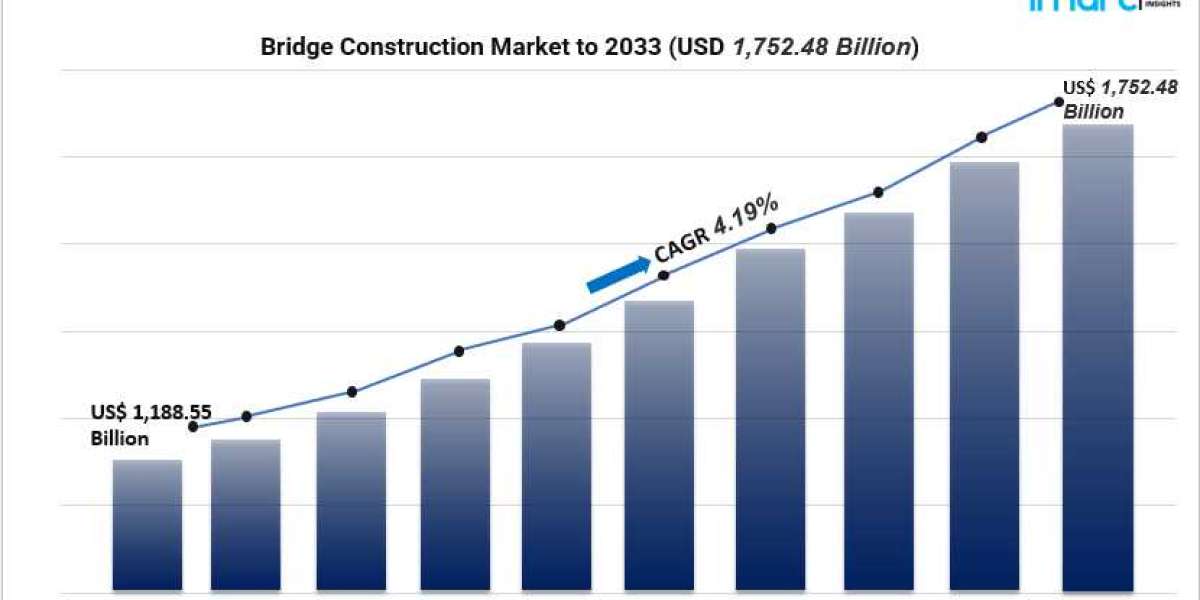Market Overview
The global bridge construction market is expanding on the back of large-scale road and rail upgrades, government megaprojects, and faster delivery enabled by prefabrication, BIM, and AI-led monitoring. Valued at USD 1,188.55 billion in 2024, the market is projected to reach USD 1,752.48 billion by 2033 at a 4.19% CAGR (2025–2033). Asia Pacific leads with just over 49.5% share, supported by dense urbanization, rising traffic, and sustained public investment.
Study Assumption Years
- Base Year: 2024
- Historical Year: 2019–2024
- Forecast Year: 2025–2033
Bridge Construction Market Key Takeaways
- Market size outlook: USD 1,188.55B (2024) → USD 1,752.48B (2033) at 4.19% CAGR (2025–2033).
- Regional leader: Asia Pacific accounts for ~49.5% share in 2024, driven by large-scale transport programs and urban connectivity goals.
- Top type: Beam bridges lead with ~36.6% share owing to simple design, speed of construction, and cost efficiency for short-to-medium spans.
- Material leader: Concrete dominates (~48.6%) due to availability, durability, and low maintenance; high-performance mixes further boost adoption.
- Leading application: Road highway projects command ~80.5% share as nations expand corridors, interchanges, and bypasses.
- Tech momentum: Prefab elements, segmental construction, BIM, drones, and AI monitoring accelerate timelines and enhance safety/quality.
Market Growth Factors
1) Transport demand public investment
The rise in vehicle ownership, increased freight movement, and the expansion of rail systems are putting pressure on existing infrastructure while simultaneously creating a steady demand for bridges across highways, border crossings, and urban areas. Governments are investing more heavily in connectivity, resilience, and expressway initiatives, which is leading to a pipeline of multi-year projects. In terms of road infrastructure, there’s a strong focus on building flyovers and interchanges to ease congestion in cities, while cross-border bridges are being developed to boost trade efficiency and security. This wave of spending is further supported by public-private partnership models that simplify financing and project delivery, especially in busy corridors. Together, these factors are driving a consistent growth trend in the market from 2025 to 2033, highlighting the ongoing importance of road and highway projects in overall capital expenditures.
2) Construction innovation productivity gains
Modern construction techniques are speeding up timelines and enhancing quality. Using prefabricated bridge components and segmental methods reduces the complexity of on-site work and boosts safety; high-performance materials increase durability and decrease maintenance needs. Digital tools—like Building Information Modeling (BIM) for coordinated design, drone surveying for quick site assessments, and AI-driven structural monitoring—help cut down on rework and delays while allowing for predictive maintenance. These advancements are particularly advantageous for beam bridge projects, where standardized, modular parts enable faster delivery on a larger scale. The outcome is quicker, more dependable execution in both developed and developing regions, empowering contractors to manage bigger, simultaneous projects without sacrificing quality or longevity.
3) Mode shift toward rail resilient design
The expansion of railway networks—whether it’s high-speed passenger lines, urban metros, or freight services—is driving a growing need for specialized bridges designed to handle heavy loads, electrification, and faster speeds. Countries experiencing rapid urban growth are busy upgrading their rail corridors, which is leading to the development of long-span solutions and durable materials that can endure intense usage. At the same time, resilience is becoming a key focus in design: features like elevated decks, flexible joints, reinforced foundations, and improved drainage systems are all aimed at reducing the impact of extreme weather and seismic events. These enhancements not only protect communities but also ensure that services remain uninterrupted. The combination of railway expansion and resilience standards is broadening the range of applications and raising technical requirements, which in turn supports ongoing value creation for providers of materials, engineering, and digital solutions.
Request for a sample copy of this report: https://www.imarcgroup.com/bridge-construction-market/requestsample
Market Segmentation
Analysis by Type
- Beam Bridge — Favoured for short-to-medium spans with straightforward design and rapid installation. Pre-stressed concrete or steel beams boost load capacity and longevity while containing costs and maintenance needs.
- Truss Bridge — Triangulated frameworks deliver strong load distribution for rail and road crossings. Suitable for longer spans where stiffness and efficient material use are prioritized during accelerated builds.
- Arch Bridge — Curved compression structures provide aesthetic, durable solutions for rivers and valleys. Effective where geological conditions support thrust transfer to abutments and long-life cycles are required.
- Suspension Bridge — Cable-suspended main spans enable iconic, very long crossings over waterways or busy straits. Ideal when navigation clearance and minimal pier placement are critical constraints.
- Cable-stayed Bridge — Direct cable-to-tower systems suit medium-to-long spans with efficient material use and visual clarity. Often selected for urban gateways balancing performance, cost, and architectural impact.
- Others — Includes niche or hybrid configurations optimized for site specifics, construction logistics, or aesthetic requirements where conventional typologies are less suitable.
Analysis by Material
- Steel — High strength-to-weight ratio supports long spans and rapid erection with modular components. Preferred for complex geometries and accelerated urban rebuilds requiring minimal traffic disruption.
- Concrete — Dominant due to availability, cost efficiency, and durability. Pre-stressed and reinforced designs deliver robust load distribution for highways and urban overpasses with lower lifecycle needs.
- Composite Materials — Fiber-reinforced solutions reduce weight and corrosion risk while improving fatigue performance. Useful for decks and rehabilitations where longevity and reduced maintenance are priorities.
Analysis by Application
- Road and Highway — Largest share driven by corridor expansion, decongestion goals, and logistics efficiency. Integrates smart road features and PPP-led tolled assets where bridges are essential system elements.
- Railway — Rising with network expansion and urban transit growth. Bridges address waterway, roadway, and terrain conflicts while supporting speed, electrification, and heavy axle loads for freight.
Regional Analysis — Breakup by Region
- North America (United States, Canada)
- Asia Pacific (China, Japan, India, South Korea, Australia, Indonesia, Others)
- Europe (Germany, France, United Kingdom, Italy, Spain, Russia, Others)
- Latin America (Brazil, Mexico, Others)
- Middle East and Africa
Regional Insights
In 2024, the Asia Pacific region is set to dominate the market with about a 49.5% share, driven by significant and ongoing public investments, the construction of expressways and railways, and a surge in urbanization that boosts connectivity needs across both national and international corridors. The rise in vehicle ownership and freight traffic further strengthens the pipeline for sustained projects.
Recent Developments News
The page also showcases innovation awards and key projects that highlight the momentum in advanced delivery models. In July 2025, ACCIONA, along with its partners, received ARTBA awards for the I-10 Calcasieu Bridge (Innovation of the Year) and Atlanta’s SR400 Express Lanes (Community Impact of the Year), showcasing the effectiveness of public-private partnerships. Additionally, in 2025, construction on China’s Taoyaomen highway-railway bridge progressed to the tower phase after crucial foundation pours, indicating ongoing advancements in complex long-span structures for rail integration. Together, these updates reflect the adoption of new technologies, resilient design principles, and large-scale project execution.
Key Players
- AECOM
- Balfour Beatty plc
- Bouygues S.A.
- China Communications Construction Company Limited
- China State Construction Engineering Corporation
- Fluor Corporation
- Kiewit Corporation
- Samsung CT Corporation
- Strabag SE
- Vinci SA
Ask Analyst for Customization: https://www.imarcgroup.com/request?type=reportid=4925flag=C
If you require any specific information that is not covered currently within the scope of the report, we will provide the same as a part of the customization.
About Us:
IMARC Group is a global management consulting firm that helps the world’s most ambitious changemakers to create a lasting impact. The company provides a comprehensive suite of market entry and expansion services. IMARC offerings include a thorough market assessment, feasibility studies, company incorporation assistance, factory setup support, regulatory approvals and licensing navigation, branding, marketing and sales strategies, competitive landscape, and benchmarking analyses, pricing and cost research, and procurement research.
Contact Us:
IMARC Group
134 N 4th St. Brooklyn, NY 11249, USA
Email: sales@imarcgroup.com
Tel No: (+1-201971-6302)














